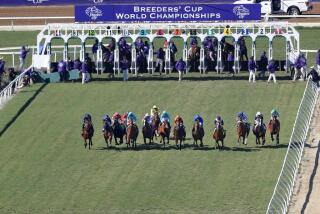Sail America Will Defend in Catamaran : Fay’s Challenge Answered; Long Beach or Hawaii Is Likely Site
SAN DIEGO — Sail America Friday confirmed that it will defend the America’s Cup late next summer in a catamaran against the monohull of New Zealand’s Michael Fay. It also said that it would do so in Long Beach or Hawaii--not the home waters of San Diego where the trophy now resides.
The catamaran part of the announcement is certain to anger Fay.
The Auckland merchant banker, dredging up challengers’ rights heretofore ignored in the 100-year-old Deed of Gift that governs Cup competition, told the San Diego Yacht Club last July that he was challenging for the Cup 10 months hence in a boat with a 90-foot waterline, the maximum allowed.
When Fay’s challenge was upheld by the New York Supreme Court, San Diego responded by telling Fay it, too, would abide strictly by the deed, which it says allows the defender to pick the venue and its own boat.
Fay disputes those two points, but San Diego now seems committed to that course.
“We’re building two boats,” John Marshall, the design team manager, said. “They’re both multihulls. One is a catamaran (two hulls). The other we’re not committing yet.”
That leaves open the possibility that the other could be a trimaran (three hulls). They will be built in California of light but strong carbon fiber material.
“The last time we were dealing with 40,000 pounds of lead attached to an ugly blob of aluminum,” Marshall said, referring to the conventional 12-meters used since 1958. “(This time) we’re going to see boats on both sides that will establish levels of performance far beyond anything we’ve seen.”
Compared to a 12-meter, which occasionally reaches a top speed of 15 knots, Marshall believes both the New Zealand and Sail America boats will be capable of more than 30 knots.
San Diego’s hope is to dispose of Fay’s challenge this year, then stage an all-comers defense in 1991--in those old “ugly blobs.”
Sail America’s first boat will be called “Stars & Stripes,” as was the blue 12-meter Dennis Conner used to win the Cup back from the Australians at Fremantle last winter. Conner, despite limited multihull experience, also will be skipper of this boat.
The boats will be built “as light as we can possibly build it,” Marshall said. “We’ve got Dennis on a diet.”
Preliminary construction started this week.
Sail America has assembled an 18-man team headed by Marshall that includes six designers, three sailing consultants, six technical consultants and two meteorologists.
The key people are the designers, especially multihull experts Dave Hubbard and Duncan Maclane of Connecticut, whose Class C catamarans have won the Little America’s Cup for multihulls five times, and Gino Morelli of Newport Beach, who designed the Formula 40 catamaran that Randy Smyth sailed to the 1986 world championship in Europe.
Smyth, the Huntington Beach sailmaker who in ’84 won an Olympic silver medal on a Tornado catamaran, also is on the team as a consultant, along with Cam Lewis and Peter Isler, who was Conner’s navigator at Fremantle.
One technical consultant is John Roncz, who designed the airfoils for the Voyager airplane which Dick Rutan and Jeana Yeager flew around the world non-stop, without refueling, a year ago.
The meteorologists will help determine the venue, but Marshall said, “San Diego is starting a little bit of a distant third. The probability is it will be someplace else. We see two strong candidate race courses that are suitable for these very high performance boats and will allow both our boat and New Zealand’s to show their stuff.”
But especially Sail America’s boat, Marshall might have noted.
“One is Hawaii, a very windy, very challenging environment,” he continued. “The other is the (‘84) Olympics/Congressional Cup course off Long Beach. That’s more a medium-wind environment, but in the month of September, which is one of the lightest-wind months in San Diego, the Long Beach course would offer a point in between.
“The new boats are not gonna get up and get flying until there’s a little breeze. Just to realize the potential in the boats, we do need some wind.”
More to Read
Sign up for The Wild
We’ll help you find the best places to hike, bike and run, as well as the perfect silent spots for meditation and yoga.
You may occasionally receive promotional content from the Los Angeles Times.






